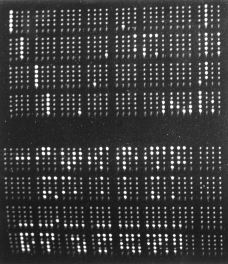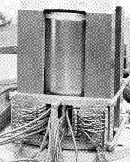

A bright spot represents a 1, a dark spot a 0.
The Williams tube was invented in 1946, and was superseded by core memory in 1955.

early innovations in UK computing
 |
This is how an ultrasonic delay line works. Inject a sound wave at one end of a tube, and it takes a long time (by standards of electronics) to emerge at the other end. As a wave emerges, an amplifier boosts and reshapes the signal and puts it back into the tube. A long tube held about 1000 waves, each representing a 1 or a 0. |
 |
The Williams tube is based on the fact that it's possible to store information in a video screen. In essence, each dot in a screen designed for this purpose functions as a capacitor, which can be either charged or discharged, and the presence or absence of charge detected. The Williams tube was significant in providing a relatively large random access (ass opposed to sequential) storage of relatively high reliability for its time. It was also the first form of storage which did not have to be meticulously wired down to the last bit.
A bright spot represents a 1, a dark spot a 0. The Williams tube was invented in 1946, and was superseded by core memory in 1955. |
 |
A magnetic drum was another early form of memory. Sequential and slower than a Williams tube, it was a forerunner of the disk. Drums were used in the first virtual memory machine, MADM, built in Manchester in 1947. The drum was accurately synchronized to the timing of the Williams tube to minimize transfer time. The drum rotated at 2000 rpm. On average, taking into account both levels of memory, a memory access took about 30ms. Compare that with about 10ms for a modern disk, or 60ns for DRAM. |
Often the underlying idea was from the US, but the British were the first to implement it. This was true of delay lines, and it's not totally clear who first thought of using a storage screen as an electrostatic memory. But in one area the British were clearly ahead: they were the first to build a large-scale vacuum tube-based computer, the Colossus. But since it was kept a closely guarded secret until the 1970s, the less successful US ENIAC is credited with being the first electronic digital computer. However, since the British had the advantage of prior experience of Colossus, with hindsight, it's not surprising that they were at least at first able to take ideas out of the lab and into workable machines faster than their US rivals.
The history of the delay line is instructive. The first such device was built by William Shockley of Bell Labs, one of the inventors of the transistor. Although the first proposal for using delay lines in a computer appeared from John von Neumann's group (a collaboration between the Moore School of Engineering at Pennsylvania and his own Institute for Advanced Study at Princeton) in 1945, the first full computer using delay lines was built at Cambridge in 1949. The Cambridge machine, EDSAC, predated Von Neumann's EDVAC, which only became operational in 1951.
Some cheaper computers used magnetic drums as their main memory. UNIVAC made a range of such computers. The drum ran at speeds of up to 17,670 rpm and was divided into bands, 20 of which had one read-write head each, with a maximum access time of 3.4ms, the time for the drum to make a complete revolution. Five bands had four equally spaced read-write heads which reduced their access time to a maximum of 0.85ms.
A good book on early British contributions is BV Bowden (ed.). Faster Than Thought, Pitman, London, 1953.
For US contributions, see HH Goldstine. The Computer from Pascal to Von Neumann, Princeton University Press, Princeton, 1972.
| Memories are Made of This 17:30 Thurs 12 September 1996 SHB5, Senate House, University of the Witwatersrand, Johannesburg, South Africa |
